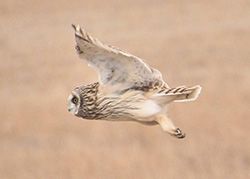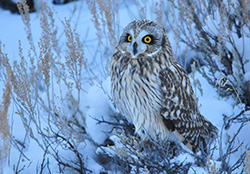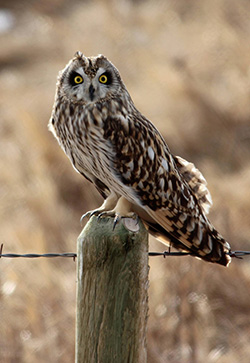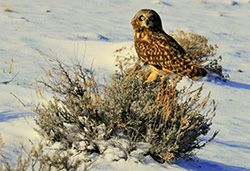 Short Eared Owl. Courtesy of the National Digital Library.
Short Eared Owl. Courtesy of the National Digital Library.
 Short Eared Owl. Courtesy of the National Digital Library.
Short Eared Owl. Courtesy of the National Digital Library.
 Short Eared Owl. Courtesy of the National Digital Library.
Short Eared Owl. Courtesy of the National Digital Library.
 Short Eared Owl. Courtesy of the National Digital Library.
Short Eared Owl. Courtesy of the National Digital Library.
A team of raptor biologists is working on a study of western populations of the Short-eared Owl – and are inviting members of the public to help collect and contribute important data as “citizen scientists.”
The project, known as the Western Asio Flammeus Landscape Study (WAfLS), is being conducted across eight western states, including Idaho, Montana, Nevada, Oregon, Utah, Washington and Wyoming, in addition to California. The purpose of the study is to determine the reasons for the sharp decline in Short-eared Owl populations – more than 60 percent over the last four decades across their western range.
“This project is a really unique and exciting collaborative effort to understand the species population on a very large scale,” said Carie Battistone, CDFW’s raptor biologist and WAfLS’ California State Volunteer Coordinator. “Given how wide-ranging – and in some cases, remote – the owls’ habitat is, we rely heavily on volunteers to help us collect the data we need.”
Battistone added that no special knowledge of raptors is needed in order for individuals to participate and contribute. “You don’t need to be a bird expert. You just need to have a keen interest in the outdoors and for the wildlife species that call California home,” she said.
The WAfLS project identifies 54 survey routes in California, all located within known habitat of the Short-eared Owl. “Citizen scientist” volunteers are needed to drive these routes, stop every ½ mile to look for and record owl presence and habitat features at each point. Volunteers will be asked to conduct two separate surveys on days of their choice during specified three-week survey windows in March through May. Each survey takes about 90 minutes and must be conducted during specified twilight hours, when the owls typically conduct their elaborate courtship displays.
Survey grids are located throughout much of the state from Modoc County in the north, Humboldt County in the west, Santa Barbara and Kern counties in the south and Mono County in the east. To view a map showing the grids for which volunteers are still needed, please visit the WAfLS website and click on “sign-up” on the right. The website also has a wealth of information on the project’s goals, as well as past reports, maps and volunteer resources (protocol, data sheets, etc.).
Battistone said that the information gathered by citizen scientists will be used by conservation experts and managers to design and implement strategies to help bolster populations of the Short-eared Owl.
“The project will help to determine what the Short-eared population numbers are like across the west, quantify how populations fluctuate spatially and temporally and identify how various factors – such as distribution, farming practices, grazing and climate – influence owls,” she said. “Once we have the data and resulting analyses in hand, we can make informed decisions on how to best protect and conserve the species.”
Owl photos courtesy of the National Digital Library. Top Photo: SEOW Survey: Surveying for Short-eared Owls can be a fun family activity. (CDFW Photo by Carrie Battistone.)
Media contact:
Kirsten Macintyre, CDFW Communications, (916) 322-8988